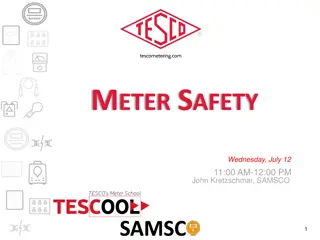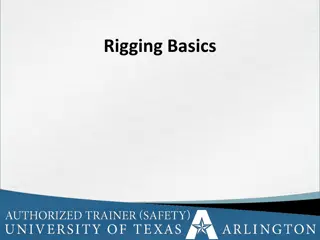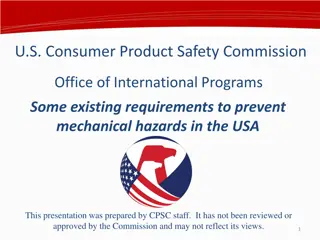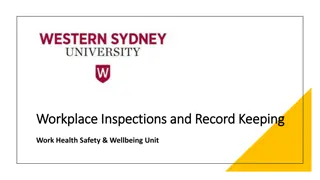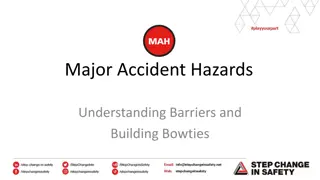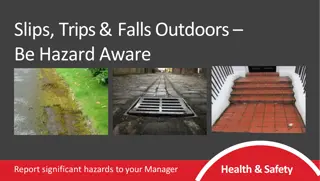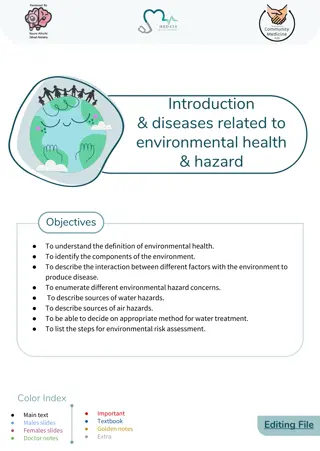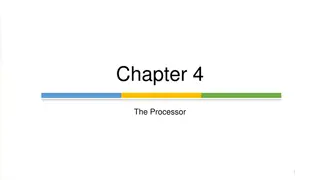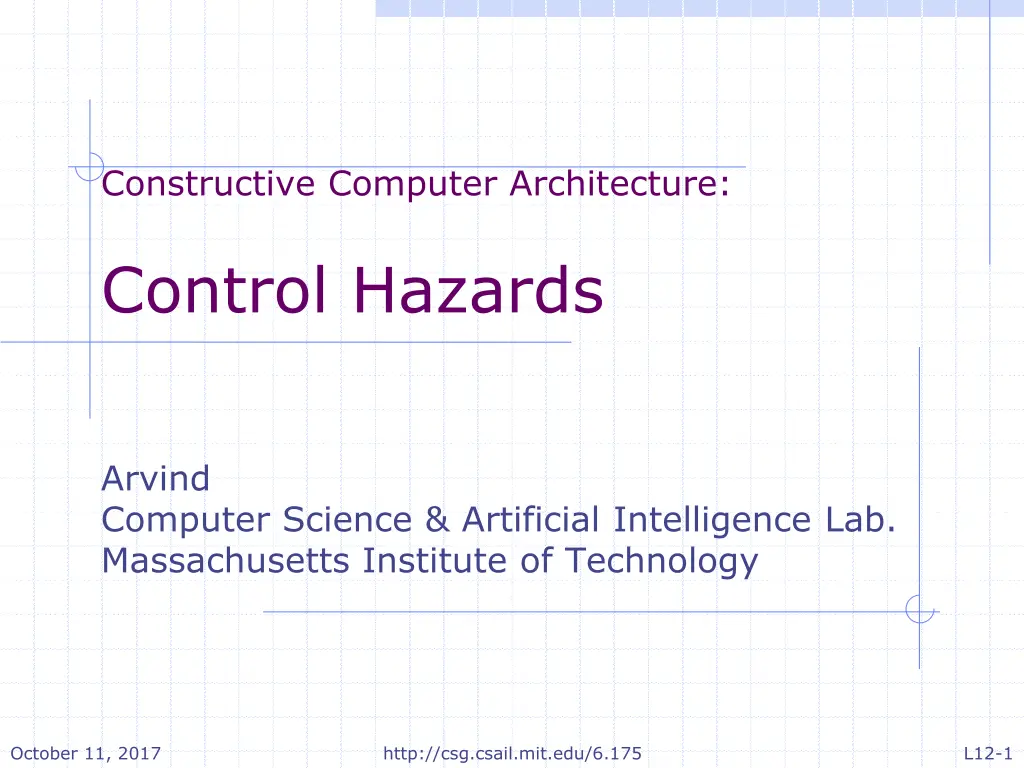
Computer Architecture Control Hazards
Explore the concept of control hazards in computer architecture with a focus on synchronous 2-stage pipelines. Learn how the pipeline handles guessed and real next-program counters, instruction fetching, and error correction. Discover strategies to improve pipeline performance through efficient prediction mechanisms.
Uploaded on | 3 Views
Download Presentation

Please find below an Image/Link to download the presentation.
The content on the website is provided AS IS for your information and personal use only. It may not be sold, licensed, or shared on other websites without obtaining consent from the author. If you encounter any issues during the download, it is possible that the publisher has removed the file from their server.
You are allowed to download the files provided on this website for personal or commercial use, subject to the condition that they are used lawfully. All files are the property of their respective owners.
The content on the website is provided AS IS for your information and personal use only. It may not be sold, licensed, or shared on other websites without obtaining consent from the author.
E N D
Presentation Transcript
Constructive Computer Architecture: Control Hazards Arvind Computer Science & Artificial Intelligence Lab. Massachusetts Institute of Technology October 11, 2017 http://csg.csail.mit.edu/6.175 L12-1
Synchronous 2-Stage Pipeline next state guessed next pc we will call it pcF real pc pc ir pc Fetch Execute invalid ir fetched instruction, ... Fetch and Execute are concurrently active on two different instructions; Fetch guesses the next pc and Execute corrects it when necessary October 11, 2017 http://csg.csail.mit.edu/6.175 L12-2
guessed next pc ir Synchronous 2-Stage Pipeline real pc pc pc Fetch Execute invalid ir fetched instruction, ... rule doPipeline ; let newInst = iMem.req(pcF); let newPcF = nap(pcF); let newIR= Valid(Fetch2Decode{pc:pcF,ppc:newPcF, if(isValid(ir)) begin let x = fromMaybe(?, ir); let pc = x.pc; let inst = x.inst; let dInst = decode(inst); ... register fetch, exec, memory op, rf update ... let nextPC = eInst.brTaken ? eInst.addr : pc + 4; if (x.ppc != nextPC) begin newIR = Invalid; newPcF = nextPC; end end pcF <= newPcF; ir <= newIR; endrule pass pcF and predicted pc to the execute stage fetch inst:newInst}); execute October 11, 2017 http://csg.csail.mit.edu/6.175 L12-3
guessed next pc ir real pc pc pc Fetch Execute Performance? invalid ir fetched instruction, ... rule doPipeline ; let newInst = iMem.req(pcF); let newPcF = nap(pcF); let newIR=Valid(Fetch2Decode{pc:pcF, if(isValid(ir)) begin let x = fromMaybe(?, ir); let pc = x.pc; let inst = x.inst; let dInst = decode(inst); ... register fetch, exec, memory op, rf update, nextPC ... if (x.ppc != nextPC) begin newIR = Invalid; newPcF = nextPC; end end pcF <= newPcF; ir <= newIR; endrule fetch Notice there is always a bubble (dead cycle) after every miss- prediction The critical path: max{tnewPcF, tnewIr} max{ max{tnap, texec}, max{tiMem, texec}} max{tiMem, texec} ppc:newPcF, inst:newInst}); execute texec includes tdecode etc. The critical path is not(tiMem + texec) October 11, 2017 http://csg.csail.mit.edu/6.175 L12-4
Elastic two-stage pipeline pc redirect PC Fetch Execute f2d <inst, pc, ppc> We replace f2d register by a FIFO to make the machine more elastic, that is, Fetch keeps putting instructions into f2d and Execute keeps removing and executing instructions from f2d Fetch passes the pc and predicted pc in addition to the inst to Execute; Execute redirects the PC in case of a miss-prediction October 11, 2017 http://csg.csail.mit.edu/6.175 L12-5
An elastic Two-Stage pipeline rule doFetch ; let inst = iMem.req(pcF); let newPcF = nap(pcF); pcF <= newPcF; f2d.enq(Fetch2Decode{pc:pcF, ppc:newPcF, inst:inst}); endrule Can these rules execute concurrently assuming the FIFO allows concurrent enq, deq and clear? rule doExecute ; let x = f2d.first; let pc = x.pc; let inst = x.inst; ... register fetch, exec, memory op, rf update, nextPC ... if (x.ppc != nextPC) begin pcF <= eInst.addr; else f2d.deq; endrule These rules can execute in any order, however, the execution of doExecute may throw away fetched instructions clear vs deq ? No, double writes in pc f2d.clear; end October 11, 2017 http://csg.csail.mit.edu/6.175 L12-6
For concurrency make pc into an EHR design 1 rule doFetch ; let inst = iMem.req(pcF[0]); let newPcF = nap(pcF[0]); pcF[0] <= newPcF; f2d.enq(Fetch2Decode{pc:pcF[0], ppc:newPcF, inst:inst}); endrule Notice, for concurrency, f2d implementation must guarantee that (enq < clear) doFetch < doExecute rule doExecute ; let x = f2d.first; let pc = x.pc; let inst = x.inst; ... register fetch, exec, memory op, rf update, nextPC ... if (x.ppc != nextPC) begin pcF[1] <= eInst.addr; else f2d.deq; endrule f2d.clear; end October 11, 2017 http://csg.csail.mit.edu/6.175 L12-7
Concurrency and Correctness Fetch < Execute pc redirect PC Fetch Execute f2d <inst, pc, ppc> Once Execute redirects the PC, no wrong path instruction should be executed the next instruction executed must be the redirected one Thus, concurrent execution requires (enq < clear) Performance? A dead-cycle or pipeline bubble after each miss prediction October 11, 2017 http://csg.csail.mit.edu/6.175 L12-8
Design 1 Performance doFetch < doExecute enq < clear rule doFetch ; let inst = iMem.req(pcF[0]); let newPcF = nap(pcF[0]); pcF[0] <= newPcF; f2d.enq(Fetch2Decode{pc:pcF[0], ppc:newPcF, inst:inst}); endrule f2d is guaranteed to be empty after each misprediction (the same as the synchronous design) rule doExecute ; let x = f2d.first; let pc = x.pc; let inst = x.inst; ... register fetch, exec, memory op, rf update, nextPC ... if (x.ppc != nextPC) begin pcF[1] <= eInst.addr; else f2d.deq; endrule f2d.clear; end October 11, 2017 http://csg.csail.mit.edu/6.175 L12-9
Design 2 doExecute < doFetch rule doFetch ; let inst = iMem.req(pcF[1]); let newPcF = nap(pcF[1]); pcF[1] <= newPcF; f2d.enq(Fetch2Decode{pc:pcF[1], ppc:newPcF, inst:inst}); endrule 1. Concurrency: should (clear < enq ) ? 2. Does this design have better performance? rule doExecute ; let x = f2d.first; let pc = x.pc; let inst = x.inst; ... register fetch, exec, memory op, rf update, nextPC ... if (x.ppc != nextPC) begin pcF[0] <= eInst.addr; else f2d.deq; endrule f2d.clear; end October 11, 2017 http://csg.csail.mit.edu/6.175 L12-10
Design 2 correctness/concurrency Execute < Fetch pc redirect PC Fetch Execute f2d <inst, pc, ppc> Once Execute redirects the PC, no wrong path instruction should be executed the next instruction executed must be the redirected one Thus, concurrent execution requires (clear < enq) Performance? No dead-cycle but the critical path length is (tiMem + texec) Slower clock means every instruction will take longer! October 11, 2017 http://csg.csail.mit.edu/6.175 L12-11
Takeaway Get the functionality right before worrying about concurrency Introduce EHRs systematically to avoid rule conflicts; analyze various designs for dead cycles and critical path lengths BSV compiler produces information about conflicts Dead cycles can be estimated by running suitable benchmark programs Estimation of critical paths is often difficult and requires hardware synthesis tools October 11, 2017 http://csg.csail.mit.edu/6.175 L12-12
Killing fetched instructions In the simple design with combinational memory we have discussed so far, all the mispredicted instructions were present in f2d. So the Execute stage can atomically: Clear f2d Set pc to the correct target In highly pipelined machines there can be multiple mispredicted and partially executed instructions in the pipeline; it will generally take more than one cycle to kill all such instructions Need a more general solution then clearing the f2d FIFO October 11, 2017 http://csg.csail.mit.edu/6.175 L12-13
Epoch: a method to manage control hazards Add an epoch register in the processor state The Execute stage changes the epoch whenever the pc prediction is wrong and sets the pc to the correct value The Fetch stage associates the current epoch with every instruction when it is fetched The epoch of the instruction is examined when it is ready to execute. If the processor epoch has changed the instruction is thrown away Fetch Execute Epoch targetPC nap inst PC f2d iMem October 11, 2017 http://csg.csail.mit.edu/6.175 L12-14
An epoch based solution Can these rules execute concurrently ? rule doFetch ; let instF=iMem.req(pcF[0]); let ppcF=nap(pcF[0]); pcF[0]<=ppcF; f2d.enq(Fetch2Decode{pc:pcF[0],ppc:ppcF,epoch:epoch, inst:instF}); endrule rule doExecute; let x=f2d.first; let pc=x.pc; let inEp=x.epoch; let inst = x.inst; if(inEp == epoch) begin ...decode, register fetch, exec, memory op, rf update nextPC ... if (x.ppc != nextPC) begin pcF[1] <= eInst.addr; epoch <= next(epoch); end end f2d.deq; endrule yes two values for epoch are sufficient October 11, 2017 http://csg.csail.mit.edu/6.175 L12-15
Discussion Epoch based solution kills one wrong-path instruction at a time in the execute stage It may be slow, but it is more robust in more complex pipelines, if you have multiple stages between fetch and execute or if you have outstanding instruction requests to the iMem It requires the Execute stage to set the pc and epoch registers simultaneously which may result in a long combinational path from Execute to Fetch October 11, 2017 http://csg.csail.mit.edu/6.175 L12-16
Decoupled Fetch and Execute <corrected pc, new epoch> Fetch Execute <inst, pc, ppc, epoch> In decoupled systems a subsystem reads and modifies only local state atomically In our solution, pc and epoch are read by both rules Properly decoupled systems permit greater freedom in independent refinement of subsystems October 11, 2017 http://csg.csail.mit.edu/6.175 L12-17
A decoupled solution using epochs Fetch fEpoch eEpoch Execute Add fEpoch and eEpoch registers to the processor state; initialize them to the same value The epoch changes whenever Execute detects the pc prediction to be wrong. This change is reflected immediately in eEpoch and eventually in fEpoch via a message from Execute to Fetch Associate fEpoch with every instruction when it is fetched In the execute stage, reject, i.e., kill, the instruction if its epoch does not match eEpoch October 11, 2017 http://csg.csail.mit.edu/6.175 L12-18
Control Hazard resolution A robust two-rule solution eEpoch FIFO fEpoch Register File redirect +4 PC Execute Decode f2d FIFO Execute sends information about the target pc to Fetch, which updates fEpoch and pc whenever it examines the redirect (PC) fifo Data Memory Inst Memory October 11, 2017 http://csg.csail.mit.edu/6.175 L12-19
Two-stage pipeline Decoupled code structure module mkProc(Proc); Fifo#(Fetch2Execute) f2d <- mkFifo; Fifo#(Addr) redirect <- mkFifo; Reg#(Bool) fEpoch <- mkReg(False); Reg#(Bool) eEpoch <- mkReg(False); rule doFetch; let inst = iMem.req(pcF); ... f2d.enq(... inst ..., fEpoch); endrule rule doExecute; if(inEp == eEpoch) begin Decode and execute the instruction; update state; In case of misprediction, redirect.enq(correct pc); f2d.deq; endrule endmodule end October 11, 2017 http://csg.csail.mit.edu/6.175 L12-20
The Fetch rule rule doFetch; let inst = iMem.req(pcF); if(!redirect.notEmpty) begin let newPcF = nap(pcF); pcF <= newPcF; f2d.enq(Fetch2Execute{pc: pcF, ppc: newPcF, inst: inst, epoch: fEpoch}); end else begin fEpoch <= !fEpoch; pcF <= redirect.first; redirect.deq; end endrule Notice: In case of PC redirection, nothing is enqueued into f2d October 11, 2017 http://csg.csail.mit.edu/6.175 L12-21
The Execute rule rule doExecute; let x = f2d.first; let inst = x.inst; let pc = x.pc; let inEp = x.epoch; if(inEp == eEpoch) begin ...decode, register fetch, exec, memory op, rf update nextPC ... if (x.ppc != nextPC) begin redirect.enq(eInst.addr); end f2d.deq; endrule Can doFetch and doExecute execute concurrently? eEpoch <= !inEp; end yes, assuming CF FIFOs October 11, 2017 http://csg.csail.mit.edu/6.175 L12-22
Epoch mechanism is independent of the sophisticated branch prediction schemes that we will study later October 11, 2017 http://csg.csail.mit.edu/6.175 L12-23




